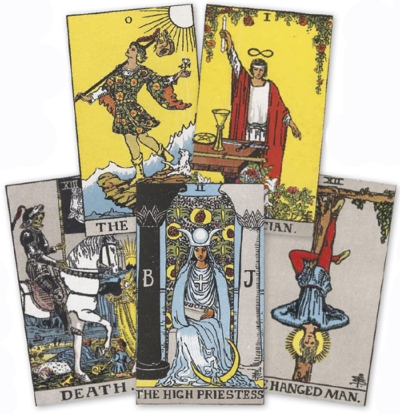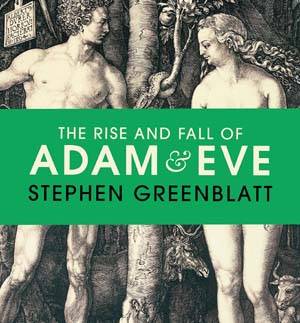
During my hippie period I regularly read the Tarot, using the beautiful Waite Rider pack. Designed in 1909 by the artist Pamela Colman Smith, influenced by the occultist AE Waite, it reflects the occult revival then in full swing. Every card is pictorial, unlike the more traditional packs, and its richly coloured images of Art Nouveau medieval figures act, like Rorschach test cards, as a trigger for musings about one’s life, a form of meditation. The cards provide a marginal space between the imaginative and the real, their images acting as a gateway to the different perception of emotions. You do not have to believe in the occult to see in the allegorical depictions of power, love, despair and hope a different mirror for your life.
The Waite Rider pack references Egyptian, Christian and Greek myths and, in A History of the Occult Tarot, Ronald Decker and the late Michael Dummett describe how a whole fake history of the Tarot was constructed by a series of 19th-century occultists who claimed to trace its legend back as far as ancient Egypt. It is not always clear how much these fantasists believed their own fakery, but for many the manufactured legends were – and still are – as compelling as those of Christianity.
For me, a non-believer, all myths are on a par. If they are imaginative and beautiful, if they resonate, then they may be valuable, but should not be misunderstood as any kind of literal truth. In The Case for God, Karen Armstrong makes a similar case for Christianity. She suggests that as a result of its encounter with science over the centuries Christianity itself became pseudo-scientific, believers reading the Bible for “facts about God” and insisting on its literal truth. For her, by contrast, religion is a practice, a discipline, one that “cultivates a perception based on imagination and empathy” and which, “backed up by ritual and ... practice, can ... still produce the sense of transcendence that gives meaning to [practitioners’] lives”. This is postmodern religion, in which the truth or otherwise of its propositions is irrelevant. It is simply a receptive state that might equally be induced by art; religion, as the 19th-century German philosopher Ludwig Feuerbach observed, as a projection of human feeling. It should follow that gazing at the Tarot is as valid (or invalid) as Christian observance, although I wonder if Armstrong would agree that to practise the Tarot is similar to following an established and powerful religion.
Fortune telling is not taken seriously and both atheists and believers would probably agree in dismissing it as “just a bit of fun" or else just rubbish. I was therefore fascinated to read the obituary of psychic astrologer Henrietta Llewelyn Davies in The Daily Telegraph (20 May 2011). She claimed to have psychic powers (she would often hear voices), studied astrology in India and wrote horoscopes for numerous magazines. She was consulted by well-known women novelists and lawyers and would give advice on any subject, from how to lead a better life to what car to buy.
Appended to the obituary were a number of comments, almost uniformly hostile, contemptuous of educated people who could believe “Dark Ages superstition” and pointing out that an obituary of Archbishop Rowan Williams should be criticised on the same grounds.
I don’t believe it’s possible to tell the future, and there is nothing occult about the choice of a car. However when, in the 1980s and 1990s, I gave “readings” at fundraising events – feminist causes or school jumble sales – their popularity surprised me. There was a degree of disavowal (or what Theodor Adorno called “disoriented agnosticism”), but the Tarot was not actually seen as just a bit of fun. I dusted down skills I had once learned as a mental health worker and was soon hearing of domestic misery, occupational redundancies and anxious hopes for a different future. On more than one occasion the person whose cards I was reading asked if she (it was usually a woman) might consult me privately, evidently assuming that I was an established clairvoyant. This was disconcerting and I eventually gave up the fundraising altogether, worried about the ethics of the enterprise.
Religion should never have been allowed to hijack all that we don’t know and pervert it into certainty. But the Tarot’s redeeming feature is its acknowledgement of mystery through the free play of visual metaphor. Its playfulness contradicts those who dismiss it as superstition. It speaks not of rules for life and dogma, but, like many secular aesthetic experiences, of possibilities.
A longer verson of this article will be included in Elizabeth Wilson’s Cultural Passions, to be published by IB Tauris in October 2012

